| Article ID | Journal | Published Year | Pages | File Type |
|---|---|---|---|---|
| 3374668 | Journal of Infection | 2012 | 8 Pages |
SummaryObjectivesAfter the last pandemic the knowledge regarding influenza A infection has improved however, the outcomes of influenza B infection remain poorly studied. The aim of this study was to compare the features of influenza B versus influenza A(H1N1)pdm09 infections during the 2010–2011 epidemic-season.MethodsA prospective, observational-cohort of adults with laboratory-confirmed influenza infection during the 2010–2011 epidemic-season was studiedResultsFifty cases of influenza B and 80 of influenza A(H1N1)pdm09 infection were enrolled. Among patients with influenza B, the median age was 34 years-old (23–64), 30% pregnant, 24% obese, 34% transplant recipients and 14% with bacterial co-infection. Twenty-eight percent of patients had pneumonia with alveolar localized pattern and five (10%) died. Pneumonia was associated with delayed antiviral therapy, older age, higher Charlson score, invasive mechanical ventilation and bacterial co-infection. Obesity and pregnancy were not associated with complicated influenza B infection. The proportion of pneumonia, admission to the ICU and mortality did not differ between cases of influenza A(H1N1)pdm09 and influenza B infection.ConclusionsInfluenza B infection causes severe infection and it is associated with pneumonia or death, similar to influenza A(H1N1)pdm09 infection. Rapid diagnosis and early antiviral therapy are necessary for managing influenza pneumonia during epidemic periods.
